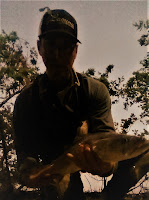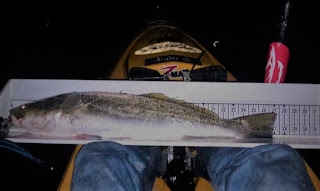 We’ve all
heard the expression, “Fishing lures are designed to catch fisherman and not
fish.” And while most of that holds true, some lures, and their design, are
true fish catching machines. So when I moved to San Antonio, TX in 2013, I was
quickly introduced to a locally produced bait called Kelly Wigglers, and told
that this bait flat out catches fish. Unfortunately for me, that was the extent
of my experience. In the 3 years I waded the TX flats, not once did the line
peel off my spool with a Kelley Wiggler Ball Tail Shad attached to the other
end.
We’ve all
heard the expression, “Fishing lures are designed to catch fisherman and not
fish.” And while most of that holds true, some lures, and their design, are
true fish catching machines. So when I moved to San Antonio, TX in 2013, I was
quickly introduced to a locally produced bait called Kelly Wigglers, and told
that this bait flat out catches fish. Unfortunately for me, that was the extent
of my experience. In the 3 years I waded the TX flats, not once did the line
peel off my spool with a Kelley Wiggler Ball Tail Shad attached to the other
end.
Actually, it
wasn’t until I moved to Florida and fished the Indian River Lagoon, that I even
considered throwing a straight tail soft plastic jerkbait. This is due in large
part to the abundance of docks, mangroves and grass surrounding many of the
local flats. Additionally, super clear water and pressured fish have made me reconsider
many of my formally written off techniques, in hopes of truly tricking one of these
monster trout into eating. That’s not the point of my product review though, the
takeaway I’d like to leave you with is a sound breakdown of Kelley Wiggler’s
most popular baits, the Ball Tail Shad or “BTS”.
SIMPLE YET UNIQUE
The BTS, by
design is truly nothing visually spectacular. “Minnow shaped” on the front, the
body carefully tapers to a rat tail earmarked with its signature BB-sized ball
on the end, hence “Ball Tail Shad.” The concept behind the ball is it gives the
tail of the bait that little extra movement when twitched or retrieved. This is
achieved due to the friction it has with the water column, and the wiggle
caused by the displaced water, thus enticing more strikes from wary trout.
 |
| 5" Kelley Wiggler BTS - Laguna Pearl |
COLORS AND CONTEXT
So, before I
get into my breakdown of the BTS, I have to provide a caveat that this review was
done solely on my dime. Baits were not provided for free or for “field testing”,
but purchased by me because I’d like to see if they produce firsthand.
 |
| Bone Diamond, Mansfield Margarita, Honey Gold |
My approach
to choosing colors was to stay natural as possible for the majority of my
purchase and choose one way “off the wall” color for fun. That said I chose 3
natural colors: Bone Diamond, Laguna Pearl and Mansfield Margarita. My one off
the wall color was Honey Gold, based off a DOA color, and local producer of big
trout, called Copper Crush.
After
receiving my shipment, I quickly noticed that all plastics were neatly placed
in the bag, with the tail straight. This is a key component for me, especially
when the key feature is the tail. By not having a straight tail, means it’s
useless to me in the confidence department, since I have visions of a bait
spinning or helicoptering down the water column.
The second
feature and most important I noticed was the clarity of the baits color pattern.
The colors subtly bled into one another, yet looked precise and natural.
Certainly something I would’ve expected for 7 plastic tails for $4.99.
Lastly, I
was interested in their durability yet pliability. On the bag, it says, “The
TOUGHEST soft plastic on the Gulf Coast”, and although I’m interested in bait
longevity, I want to see if they compromised natural bait movement for plastic
hardener. Again, at first glance it looked like a nice mix of the two…more on the
durability piece later.
TAKIN’ ‘EM FISHING
Less than 2
days after getting my shipment, I donned my wading gear for a local flat that
produced numbers of nice quality trout a week earlier. The key to this spot was
making long cast due to the super clear water. The bottom contour I was fishing
was a “dead end” under water trough that centered itself onto a clean sandy
flat outlined with Florida’s tangly mangroves. I chose to throw bone diamond on
a 1/8oz jighead first since it was the most natural of the 4 colors. Less than
3 casts into my trip I caught a beautiful 18” trout.
Here’s where
this applies to my product review. Due to the bait density, I actually
lightened my jighead to a 1/16oz to
ensure I got the slow sink effect I was searching for. That said, I never sacrificed
my cast ability despite going lighter. In other words, these baits cast very
well, and will not spin when thrown. Additionally, when fishing I used very
short quick twitches between long pauses to produce the erratic movement and
the slow sink of the bait produced something the fish were agreeable too. I did
mess with shorter cast to visualize the bait moving through the water and what
I had envisioned was confirmed. The only issue I had initially was threading
them straight and dead center to the lure. I did experience some spinning
initially, but after careful placement of my jighead, the spinning ceased.
 |
| 1/16oz Norton Screw Lock |
DURABILITY
This
particular day, I probably caught close to 20 trout up to 23”s using both of
the colors I threw; Honey Gold and Bone Diamond. Again, I paired them with the 1/16ozNorton Lure Black Nickel screw lock jighead and I used 3 tails, 2 Bone Diamond
and 1 Honey Gold. I would have only used 1 soft plastic if it wasn’t for small
jacks and my intrigue in other color patterns. In other words, this bait, if
paired with a screw lock, will last 20+ fish. The only tender spot I noticed on
the lure was on the back of the bait, which is earmarked by the word “Kelley”.
After 5 or so fish this area would tear some, but it didn’t affect the baits
performance.
 |
| "Chewed Up" |
PRO’S
- - Packaged properly
- - Great fish catching colors
- - Above average durability (if fished on a Screw-lock jighead)
- - Great castability
- - Easy to fish, especially finesse fishing
- - Great action
CON’s
- - Will spin if not threaded on hook straight
- - Tendency to tear at the hook exit point when fighting a fish
SHOULD YOU ADD THEM TO YOUR ARESENAL?
I would
highly suggest giving these a try. As mentioned in my introduction, regarding
lures attracting more fisherman than fish, the simple design of these baits
surely won’t turn heads, but they flat out catch fish. After now having
multiple successful trips under my belt, my only regret is I wish I would have
had them in my tackle arsenal 3 years ago while wading the Lower Laguna Madre. In
hindsight, its okay though, I’ll just have to continue to introduce these FL
fish to a tried and true Texas bait and hopefully the fish follow suit of the
infamous slogan about EVERYTHING being bigger. Seriously, though, if you are
considering buying some of these baits, I highly recommend them and hope they
produce for you like they did for me.
Tight Lines
and God Bless,
Chris
For More Information Visit








